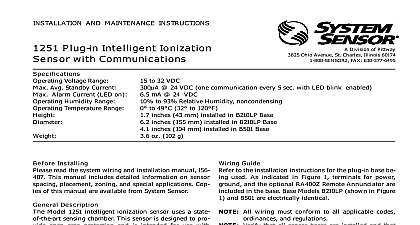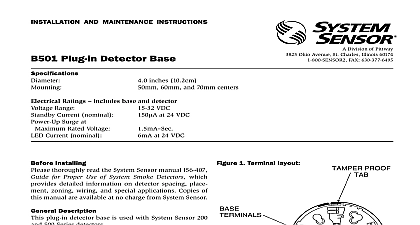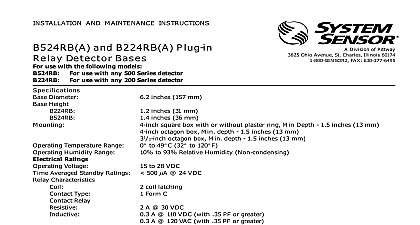System Sensor wfdtnr Install and Maint Instructions

File Preview
Click below to download for free
Click below to download for free
File Data
| Name | system-sensor-wfdtnr-install-and-maint-instructions-6582347901.pdf |
|---|---|
| Type | |
| Size | 660.88 KB |
| Downloads |
Text Preview
SYsTEM SENSOR Division of Pittway 3825 Ohio Avenue St Charles Illinois 60174 FAX 630 377 6495 AND MAINTENANCE INSTRUCTIONS Vane type Detector Ratings Threshold Bandwidth Flow Rate 4 10 GPM Pressure Rating Installed Temperature Range Weight A 125 250 VAC A 24 VDC PSI Max 31 4 W 41 4 D above pipe tee F 120 F 0 C 49 C lbs Read Carefully And Save instruction manual contains important information the installation and operation of waterflow detectors who install waterflow detectors for use by oth must leave this manual or a copy of it with the user all instructions carefully before beginning Tee Depth Requirements Figure 1 Depth Threaded Sweat Poly B CPVC 1 1 11 4 1 11 2 1 2 1 CPVC Central 1 4 1 Mounting dimensions vane type waterflow detectors in wet pipe systems DO NOT USE IN DRY PIPE DELUGE OR PRE AC SYSTEMS The sudden inrush of water in such sys may break the vane off or damage the mechanism Do use in potentially explosive atmospheres Do not leave wires exposed 3 4 1 4 Of Operation waterflow detectors mount to wet pipe systems Water flow in the pipe deflects a vane Deflection of vane produces a switched output All detectors will ac on a sustained flow of water greater than 10 gallons minute gpm but will not activate if the flow rate is than 4 gpm Pipe Tees WFDTNR fits 1 NPT threaded ferrous and 1 2 sweat brass 11 2 polybutylene plastic and 1 plastic tees having a 1 threaded NPT branch see Fig 1 and chart for recommended tee depths Guidelines installing any waterflow alarm device be thor familiar with 72 Maintenance and Use of Local Signalling Systems DEPTH TO DEPTH TEE ADAPTOR END OF TREE FIT TOP TEE AND OF HEX ADAPTOR TEE FITTING VANE 13 25 of Sprinkler Systems specifically 3.17 Testing and Maintenance of Sprin Systems specifically Chapters 4 and 5 for Residential Dwellings for Multifamily Dwellings 13D 13R applicable NFPA standards local codes and the re of the authority having jurisdiction to follow these directions may result in failure of the to report a waterflow condition System Sensor is Manuals Online 2 Assembly diagram PROOF P N WFDW SCREW Use of thread sealant or tape is recommended height gage located at end of paddle tee to ensure depth of detector on tee fitting See Figure 1 gage must fit between top of tee fitting and under of hex tee adapter A gap between gage and tee is acceptable When correctly installed the de must face in the proper direction of waterflow and aligned with the pipe Remove the plastic cover with the tamper proof wrench Move the actuator lever back and forth to for binding If the vane binds remove the detector correct the problem before proceeding NPT THREAD FLOW sure the direction of flow arrow points in the correct di otherwise a waterflow condition will go unre See Figure 2 responsible for devices that have been improperly in tested or maintained Mount the detector where there is adequate clearance installation and removal and a clear view of it for in See Figure 1 for mounting dimensions Locate to protect from damage 6 7 feet above the floor On horizontal runs position the detector on top of the or on the side Do not mount it upside down Mount detector at least 6 inches from a fitting which the direction of the water flow BE SURE DIRECTION OF FLOW ARROW MATCHES AC DIRECTION OF FLOW IN THE PIPE Instructions This WFDTNR waterflow detector is designed to fit only appropriate tee fitting Leg of tee perpendicular to flow of water must a 1 NPT thread Do not use a reducer to the correct thread size Failure to follow instruction will result in failure of the detector report a waterflow condition WFDT units are shipped without the paddles mounted to actuator Select the correct size paddle for the tee be used the appropriate nominal pipe diameter size is on the surface of the paddles Align hole on of paddle with hole on actuator lever Fasten to using a 4 40 x 1 4 fillister head screw supplied bag assembly See Figure 2 Use only the screw pro with the WFDTNR Drive screw head through hole paddle until it seats firmly to actuator lever surface washer is required For paddle replacement refer to section Thread detector onto tee fitting and tighten with Testing notify a central station monitoring waterflow before repairing maintaining or testing waterflow devices Fill the sprinkler and check for leaks around the If it leaks check to see that the fittings are If leak persists drain the system and remove the see removal instructions under Maintenance for damaged threads or cracked fitting Reinstall and check again for leaks Do not proceed until leaks have been stopped With cover removed connect an ohmmeter or continu tester across COM and B terminal switch contacts ohmmeter should show an open circuit no continu when the red switch buttons are depressed Deflect the actuator lever to release the switch buttons ohmmeter or continuity tester should show a short when the switch buttons are released Open the inspector test valve to allow the detector to a flow condition The detector should remain until the inspector test valve is closed Air in the sprinkler system may prevent the detector firing immediately Replace the cover and tighten the security screws with tamper proof wrench Store wrench is a secure place Wiring The WFDT has two SPDT switches Switch contacts and B are closed when water is flowing and open water is not flowing Connect the switches as in Figure 3 depending on the application When connected to a listed sprinkler fire alarm control the initiating circuit must be non silenceable Manuals Online 3 Field wiring 1 Common and B connections will when vane is deflected i e water is flowing Dual switches applications to be combined a single detector 2 RATINGS AMPS AMPS VAC VDC Gauge i resistor FACP Connection nonsilenceable initiating of listed FACP power source bell Local Bell Connection wire as shown for of connection NOT allow stripped wire to extend beyond housing DO NOT wires A ground screw is provided with all WFDT units When is required clamp wire with screw in hole lo between conduit entrance holes See Figure 2 Voltage Electrocution Hazard Do not handle live AC or work on a device to which AC power is applied so may result in severe injury or death prevent accidental water damage control valves should shut tightly and the system completely drained before detectors are removed or replaced detectors monthly for leaks Test detectors at least as described under Operational Testing to insure operation This device is not designed for use on pipe systems Test more often if required by the au having jurisdiction normal conditions System Sensor waterflow detec should provide years of trouble free service If how the switch enclosure becomes faulty request Part


